This is our blog with all of our tips and tricks! We have so many that we decided to put them on paper (well digitally). Please use this as a resource to help you start your design process. If you need any additional help, please don't hesitate to reach out.
categories:
welcome to our
home.
Remodel
Design
Shutters
Tips & tricks
Quick Facts:
- Home decor transitional style blends modern minimalism with traditional warmth for balanced, timeless spaces
- Neutral color palettes like cream, taupe, and gray form the foundation of this versatile design approach
- Transitional interiors mix classic furniture silhouettes with contemporary finishes for visual harmony
- This style works beautifully for homes of any size and adapts easily to different budgets
- Professional interior design services for transitional spaces typically cost $3,000 to $10,000 per room in Houston
For more inspiration on how transitional design is evolving, take a look at the newest Interior Design trends Houston 2026, which highlight the warm tones, natural textures, and timeless materials homeowners are loving.
Introduction to Home Decor Transitional Style
Home decor transitional style can be a tough decision if your not sure what it means. If you ever felt torn between sleek modern design and cozy traditional charm then you’re not alone. Many homeowners face this choice. The good news? You don’t have to pick just one.
Transitional style gives you both types of design. It’s the perfect balance. You get comfort and sophistication. Clean lines meet classic details. The result feels fresh yet timeless.
This approach creates rooms people actually want to live in. They look beautiful in photos. But more importantly, they feel right every single day. No cold minimalism. No stuffy formality. Just balanced, inviting spaces.
At Two Sisters Designs, we help Houston homeowners bring this style to life. We create spaces that feel effortless and elegant. Most importantly, they feel genuinely livable.
If you adore french home interiors, explore how transitional home décor adds comfort and versatility.
What Defines Home Decor Transitional Style?
Transitional style sits right between two worlds. Think of it as a bridge. On one side, you have modern minimalism. On the other, traditional warmth. Transitional design connects them beautifully.
This style is all about harmony. You layer textures thoughtfully, mix furniture from different eras. You create visual balance throughout your space. Nothing feels too formal. Nothing feels too stark.
The beauty lies in the details. A sleek sofa pairs with a classic armchair. Modern lighting hangs above a traditional dining table. Contemporary art adorns walls with crown molding. Each element has purpose.
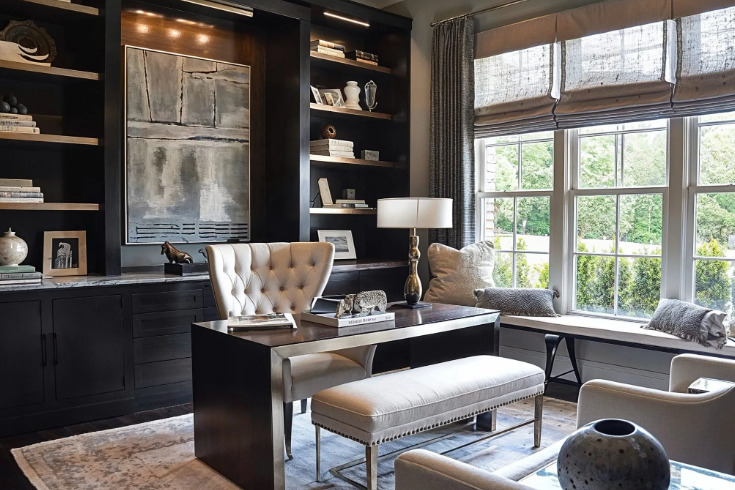
Core Characteristics Include:
- Neutral foundations with creams, taupes, grays, and soft whites
- Classic furniture shapes with contemporary finishes and materials
- Textural variety through wood, linen, glass, and metal combinations
- Balanced layouts that feel open yet inviting and comfortable
- Timeless furnishings that resist trends and last for years
The goal is simple. Create curated spaces, not cluttered ones. Make rooms feel relaxed, not rigid. Achieve comfort without sacrificing style.
The Core Elements of Transitional Style
Color Palettes That Create Foundation-Home Decor Transitional Style
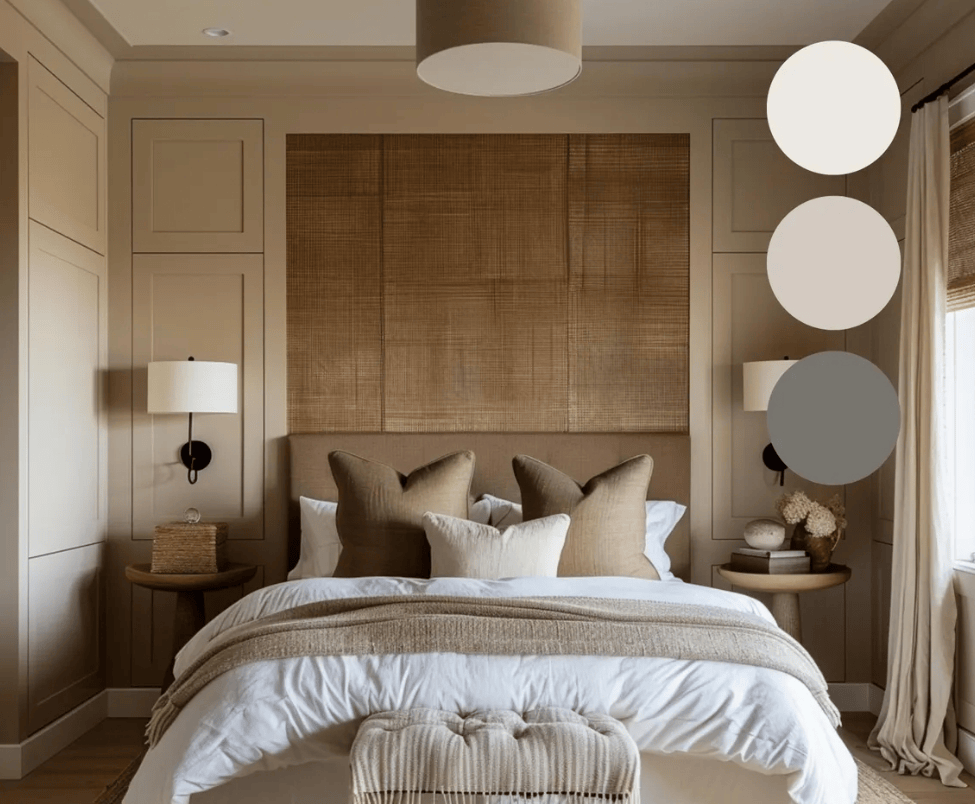
- Website: www.sherwinwilliams.com
- Address: 4615 Hwy 6, Sugar Land, TX 77478
- Phone: (281) 980-3520
Timeless interior design using neutrals help build the backbone of transitional design. These soft colors create calm. They provide the perfect canvas. And they never go out of style.
Start with your walls. Soft beiges work beautifully. Warm grays feel sophisticated. Greiges blend the best of both. These base colors let everything else shine.
Layer in subtle contrast next. Warm woods add richness. Brushed metals bring shine. Soft whites create brightness. These layers build depth without overwhelming.
You can add accent colors too. But keep them muted. Soft blues feel peaceful. Sage greens add freshness. Dusty pinks bring warmth. Just use them sparingly.
The key is restraint. Too many colors create chaos. Stick to your neutral base. Add one or two soft accents. This approach feels sophisticated and timeless.
For design inspiration, see how Revolution Fabrics complement transitional home décor.
Furniture That Blends Eras-Home Decor Transitional Style
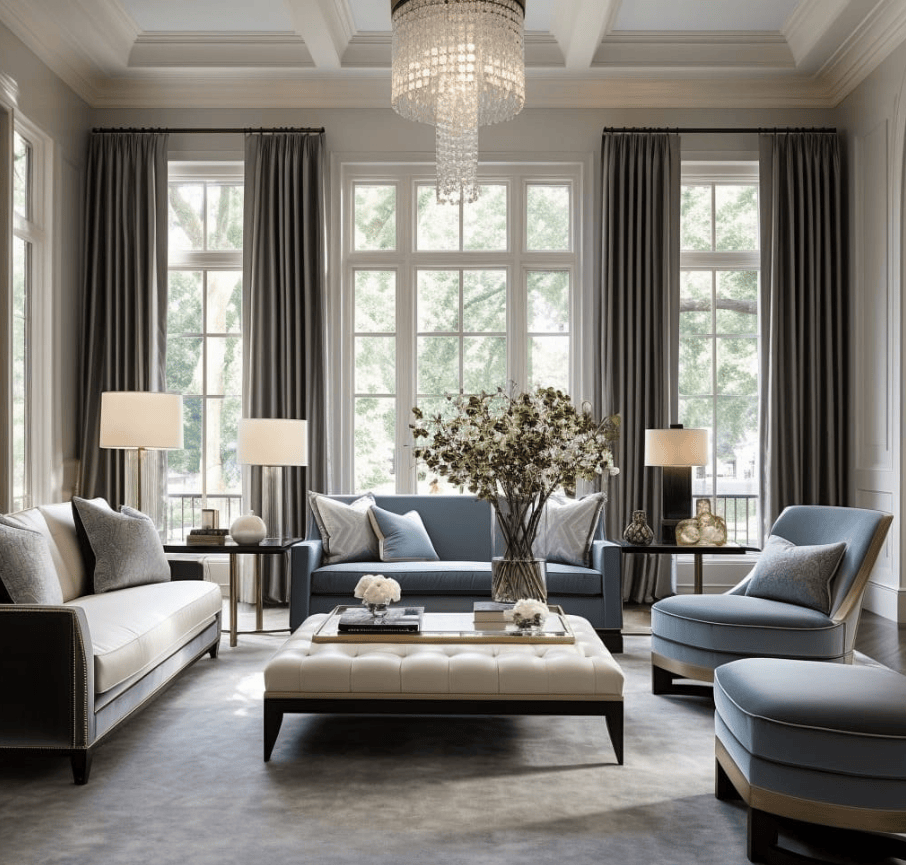
Furniture choices define transitional style and help design a curated transitional room. You need pieces from both design worlds. This mix creates the signature balanced look.
Choose modern pieces with soft edges. Pick traditional items with clean lines. Avoid anything too ornate. Skip ultra minimalist pieces too. You want the middle ground.
A sleek sofa becomes your anchor. Add a tufted armchair for contrast. Place a streamlined coffee table nearby. Include an antique console for character. See how this works?
Material mixing matters here. Linen upholstery feels soft and inviting. Dark walnut frames add richness. Glass surfaces keep things light. Metal accents provide shine.
Scale everything appropriately. Large rooms need substantial pieces. Small spaces require streamlined furniture. But always maintain visual balance. Heavy traditional pieces need modern counterparts.
Textures and Finishes That Add Depth-Home Decor Transitional Style
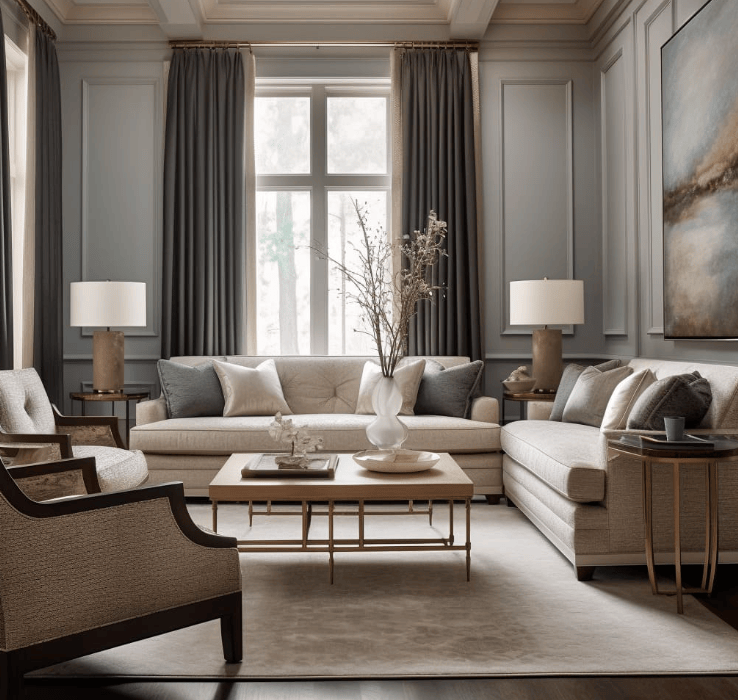
Texture brings transitional spaces to life. Without it, rooms feel flat. With it, spaces gain interest and warmth.
Start with your larger textured pieces. A plush area rug grounds the room. Woven baskets add natural texture. Linen curtains soften windows. These create your foundation.
Layer in additional textures next. Velvet pillows add luxury. Cotton throws bring coziness. Metallic lamps provide contrast. Each layer builds visual interest.
Mix hard and soft materials. Wood furniture needs soft textiles. Smooth glass pairs with rough stone. Sleek metals balance natural fibers. This contrast creates richness.
Choose two or three texture types per room. More than that gets busy. Less feels boring. This sweet spot creates cohesion. Everything feels intentional, not random.
For inspiration, explore my favorite drapery ideas for living room to complete your transitional look.
Lighting and Decor That Complete the Look-Home Decor Transitional Style
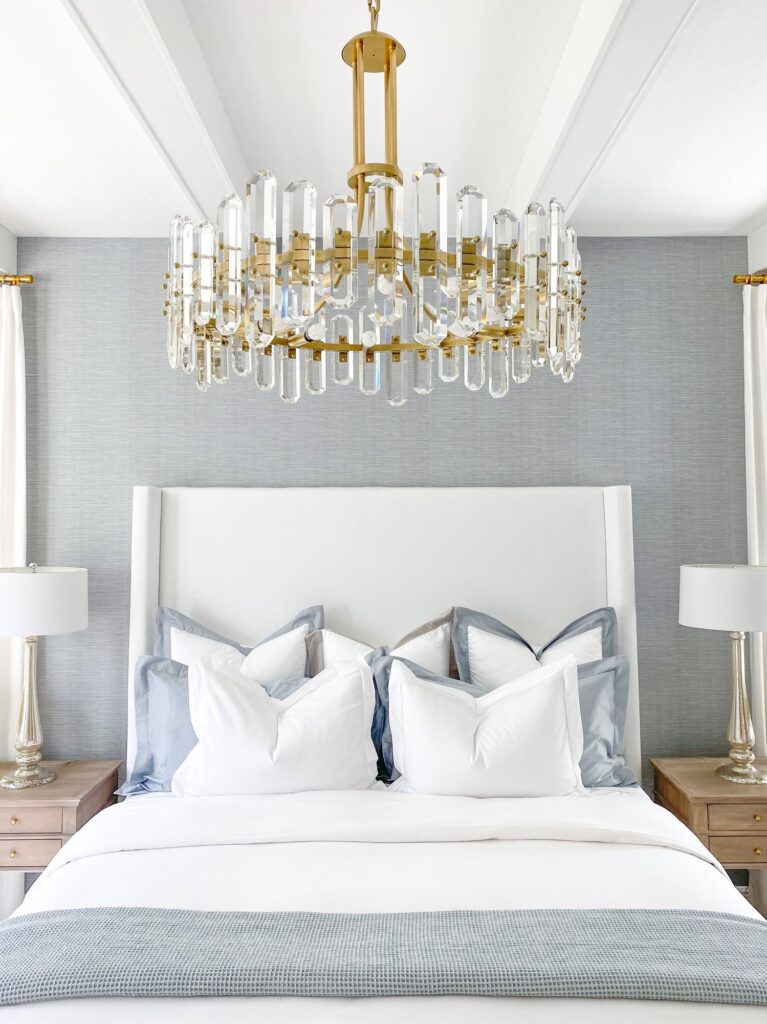
- Website: www.lightopia.com
Lighting completes an elegant transitional design. It’s not just functional. It’s a key design element. The right fixtures transform spaces.
Combine different lighting types. Modern chandeliers make statements. Glass pendants feel contemporary. Traditional sconces add warmth. Layer these for perfect illumination.
Choose fixtures that blend styles. A chandelier with clean lines. Sconces with simple details. Floor lamps mixing materials. These bridge both design worlds.
Decor needs restraint here. Less truly is more. Select meaningful pieces. Display them thoughtfully. Create breathing room around each item.
Statement mirrors work beautifully. They reflect light and space. Ceramic vases add sculptural interest. Abstract art brings personality. Just avoid overcrowding surfaces.
Quality beats quantity every time. Ten cheap items create clutter. Three beautiful pieces make impact. Choose wisely. Display sparingly.
How to Bring Home Decor Transitional Style Into Your your Designs
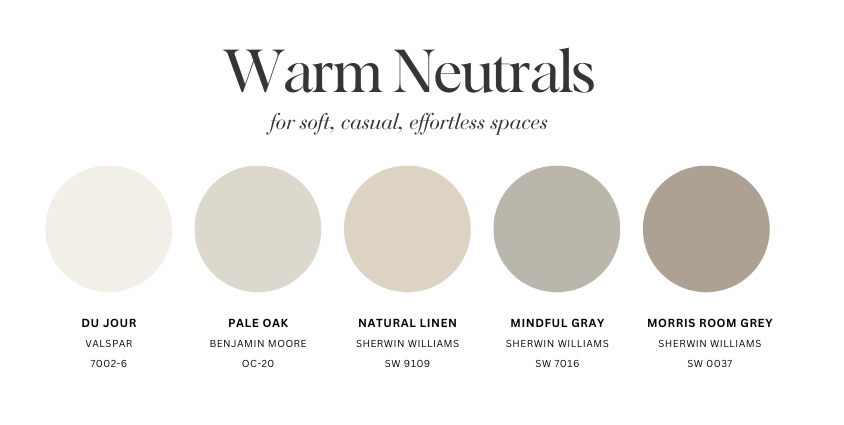
Start With Neutral Foundations
Begin with your biggest elements. Paint walls in soft neutral tones. This creates your canvas. Everything else builds from here.
Choose flooring that works both ways. Light to medium wood feels warm. Neutral tile stays timeless. Soft carpet adds comfort. These options support any furniture style.
Your large furniture pieces come next. Invest in a quality sofa. Pick a neutral upholstery color. Choose clean, simple lines. This anchors your entire room.
Window treatments soften spaces. Simple linen curtains work perfectly. Roman shades feel tailored. Avoid heavy, ornate drapery. Skip stark blinds alone. Find the middle ground.
Budget wisely for these foundations. Expect to spend $5,000 to $8,000 for a living room. This covers paint, quality sofa, basic lighting, and window treatments. You can phase this over time.
Mix Modern and Traditional Furniture-Home Decor Transitional Style
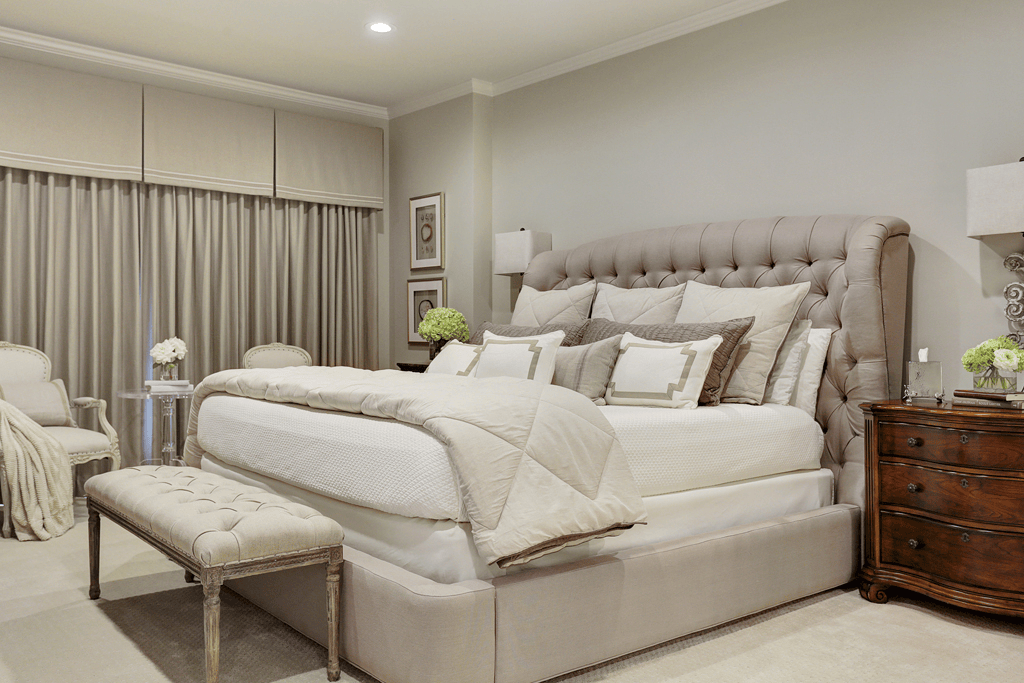
Now the fun begins. Mixing furniture creates the transitional look. Start by assessing what you own. Some pieces probably already work.
That traditional dresser from your grandmother? Keep it. Your modern coffee table? It stays too. See what bridges both styles. Build around these pieces.
Shop with clear intention. Look for furniture with simple silhouettes. Avoid matching sets completely. Mix wood tones confidently. Vary your furniture heights.
A modern dining table pairs beautifully with upholstered chairs. Traditional nightstands work beside contemporary beds. Classic armchairs anchor modern living rooms. This mixing creates interest.
Give each piece breathing room. Don’t crowd your furniture. Leave empty space between items. This makes rooms feel larger. It also lets each piece shine.
Layer Textures Throughout-Home Decor Transitional Style
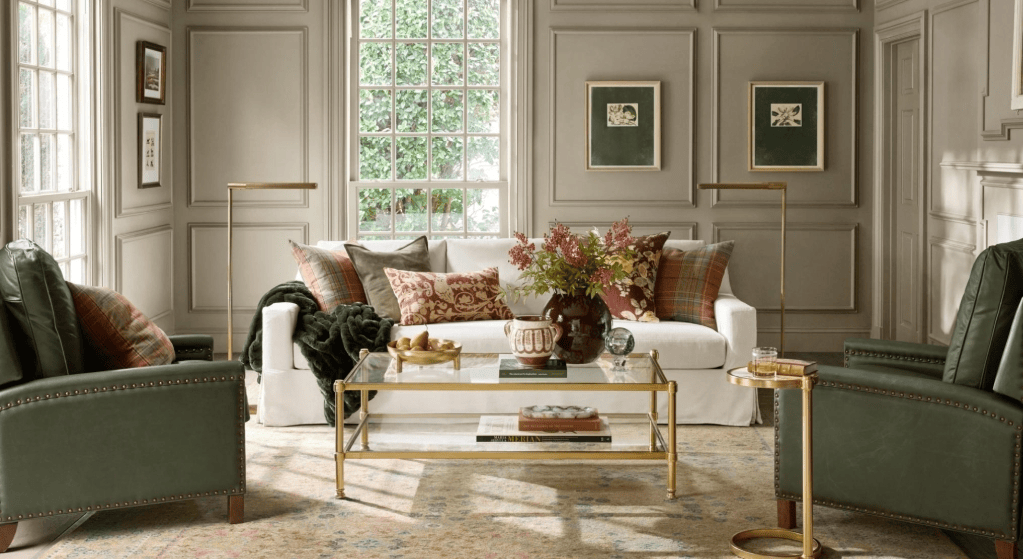
- Website: www.potterybarn.com
- Address: 4011 Westheimer Rd, Houston, TX 77027
- Phone: (713) 627-8901
Layering takes practice for the home decor transitional style. But it transforms ordinary rooms. Start with your foundation texture. Usually this is a substantial rug.
Add fabric layers gradually. Throw blankets on sofas. Decorative pillows in various textures. Curtains that add softness. Each layer increases comfort.
Bring in varied materials. A wood coffee table. A glass side table. A metal floor lamp. A ceramic vase. These different materials create richness.
Use the rule of three. Group three pillows together. Display three candles on a shelf. Hang three frames as a collection. This creates natural balance.
Don’t match everything perfectly. Variety looks collected. Matching looks store bought. You want curated, not coordinated.
If you’re updating your home, it helps to understand average bathroom renovation costs and how smart material choices can help you stay on budget while maintaining that timeless transitional look.
Keep Decor Minimal but Meaningful
Home decor transitional style requires editing. You can’t display everything. Choose your favorites. Store the rest. Rotate seasonally if desired.
Every item should earn its spot. Ask three questions. Does it serve a function? Will it bring joy? Does it fit the style? Remove anything that doesn’t qualify.
Embrace empty space. Blank wall areas feel restful. Clear countertops look luxurious. Uncluttered shelves showcase displayed items. This restraint looks expensive.
This approach saves money too. You buy less overall and also, you choose more carefully. You appreciate what you have. Quality over quantity always wins.
These timeless interiors pair beautifully with custom Houston shutters.
Creating Home Decor Transitional Style – Room by Room
Living Rooms That Welcome Everyone
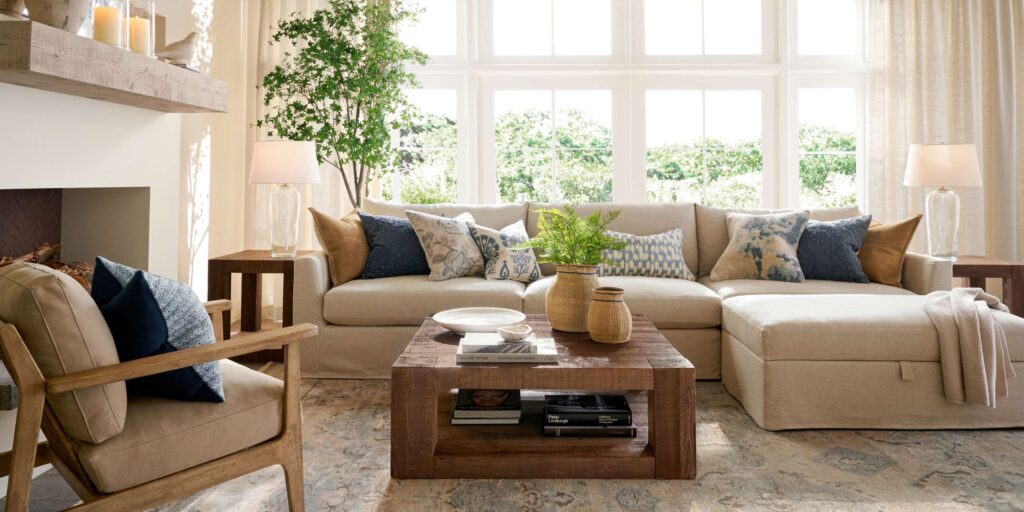
Your living room sets your home’s tone. Start with a neutral sofa. Choose a comfortable, classic shape. Add a traditional accent chair. Include a modern coffee table.
Layer in texture through accessories. Throw pillows in varied fabrics. A plush area rug underfoot. Simple curtains at windows. A statement light fixture overhead.
Mix your surface materials. Wood end tables. A glass coffee table. Metal lamps. Ceramic decor pieces. This variety creates visual interest.
Keep surfaces mostly clear. A few books on the coffee table. One or two decor items per surface. This uncluttered approach feels sophisticated.
Full service interior design for living rooms costs $3,500 to $7,000 in Houston. This includes space planning and furniture selection. Plus complete styling and installation. The investment creates cohesive, lasting spaces.
Bedrooms That Feel Like Retreats with Home Decor Transitional Style
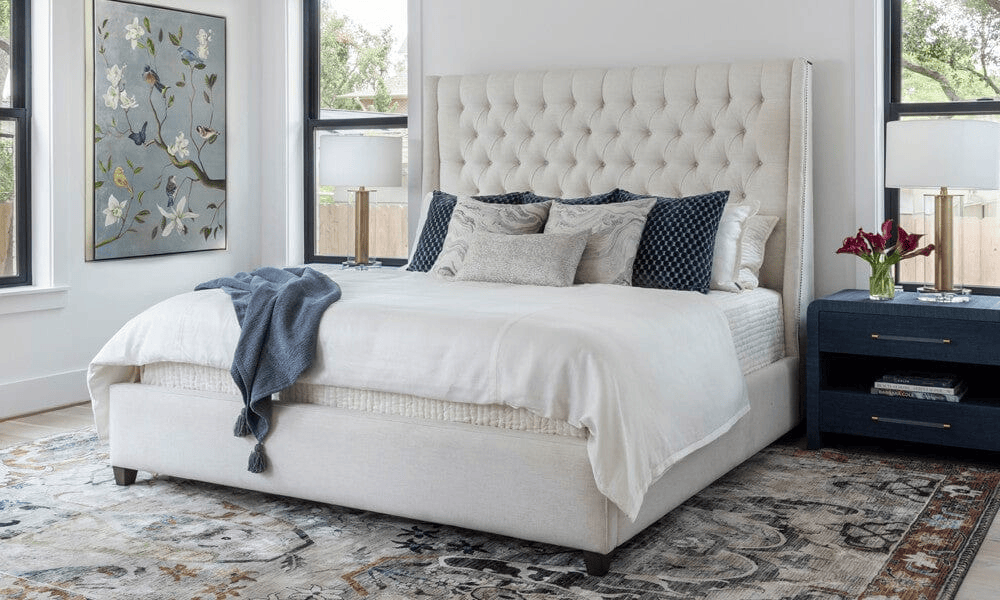
- Website: www.highfashionhome.com
- Address: 3100 Travis St, Houston, TX 77006
- Phone: (713) 528-3838
Bedrooms need maximum comfort. Choose a substantial bed frame. Upholstered or simple wood both work. Dress it in quality linens. Layer your bedding for luxury.
Your nightstands can differ from each other. One traditional, one modern creates interest. Table lamps provide necessary light. Choose complementary but unmatched styles.
Add a bench at the foot of your bed. This provides function and fills space. Include a cozy rug underfoot. Nothing beats soft texture in the morning.
Keep bedroom decor very minimal. A few framed pieces on walls. Maybe one or two plants. A decorative tray on the dresser. Less is definitely more here.
Dining Rooms That Gather People-Home Decor Transitional Style
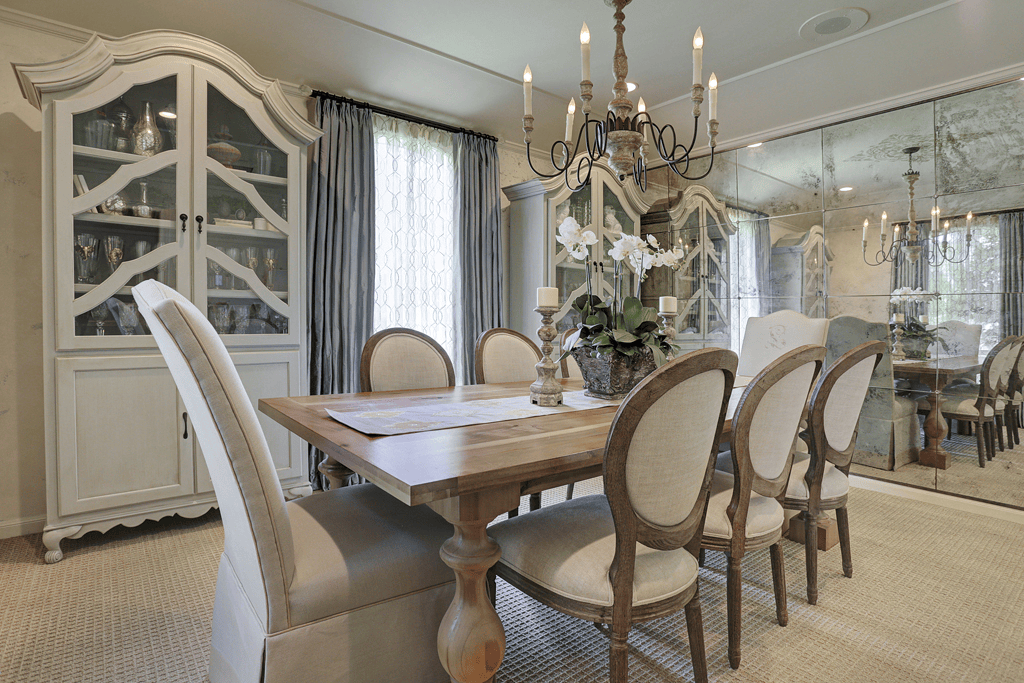
Home Decor Transitional style in dining rooms can showcase this design beautifully. Choose a simple wood table. Pick one with clean lines. Surround it with upholstered chairs. Or mix wood and upholstered seats.
Lighting is crucial in dining spaces. Center a chandelier over the table. Choose one blending both styles. Make sure the scale feels right. Not too small, not overwhelming.
Add a sideboard for storage. Style it simply and thoughtfully. Hang a large mirror above. This reflects light beautifully. Add a few decorative objects. Include fresh flowers when possible.
Keep your color palette neutral. This makes dining feel elegant. It photographs beautifully for gatherings. And it lets your food become the color on the table.
Kitchens That Balance Function and Beauty
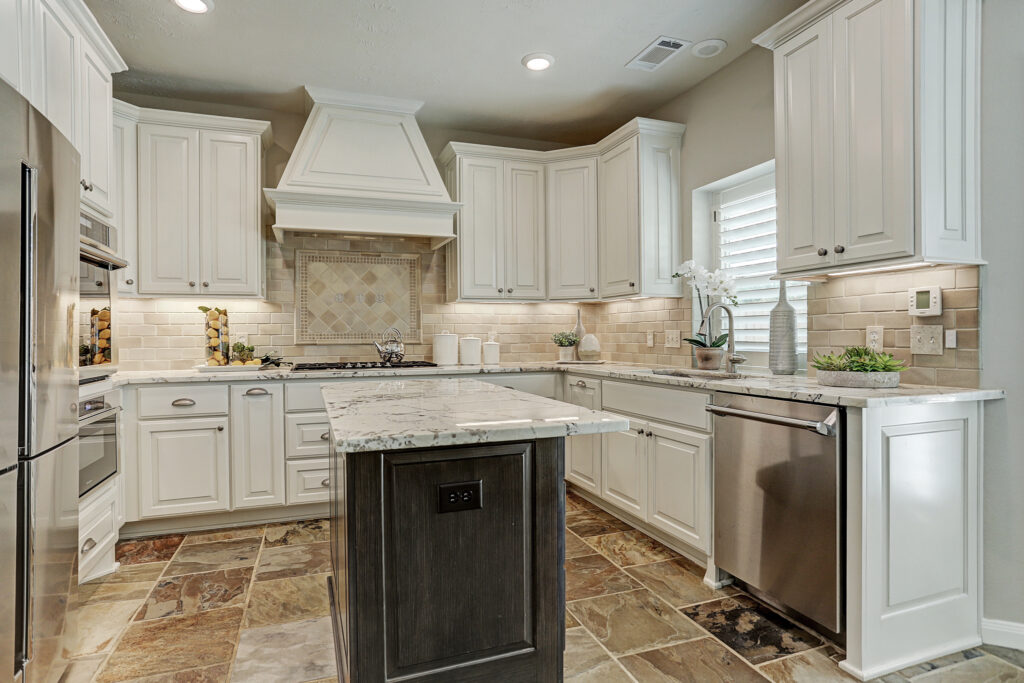
Home decor transitional style kitchens blend practicality with design. Choose simple cabinet doors. Shaker style works or raised panel works here perfectly . Paint them neutral. White, gray, or greige stay timeless.
Select durable, beautiful countertops. Quartz offers both qualities. Marble adds elegance. Granite is budget friendly. Choose colors coordinating with cabinets. Keep patterns and veining subtle on the backsplash and countertops. This floor is slate and has a slight more pattern than most slates. But it still works well in this kitchen because the cabinets and tile backsplash are simple.
Hardware matters more than most realize. Simple pulls and knobs add polish. Choose brushed nickel or brass. They should feel substantial, not ornate. Replace builder grade hardware immediately.
Open shelving can work sparingly. Display white dishes only. Add pretty glassware. Include a few cookbooks. But don’t overdo it. Too much looks cluttered quickly.
Common Mistakes to Avoid
Matching Everything Too Perfectly
Matching screams furniture store display. It lacks personality completely. Mix your furniture instead. Vary your finishes. Use complementary, not matching, styles.
Your wood tones don’t need to match. Light oak can live with dark walnut. What matters is overall balance. Too much of one tone overwhelms. A mix looks collected and interesting.
Same applies to metal finishes. Mix brushed nickel with brass. Combine matte black with bronze. Just distribute them evenly. This creates cohesion without matching.
Using Too Much Pattern
Home decor transitional style needs pattern restraint. One bold patterned piece per room works. More than that loses the calm feeling.
Choose your pattern piece carefully. Maybe a beautiful area rug. Perhaps patterned throw pillows. Or printed curtains. Let it be the star. Keep everything else solid.
When using pattern, stay within your palette. Geometric designs in gray and white. Subtle florals in beige and cream. These add interest without overwhelming.
Skipping the Texture Layers
Flat rooms feel unfinished and boring. You need depth. This comes from layered textures. It also needs varied heights. And mixed materials.
Add height variation throughout. Tall floor lamps. Substantial table lamps. Artwork at different levels. Plants of various sizes. This creates visual movement.
Layer horizontally too. Rugs over hardwood floors. Throws over sofas. Pillows in different textures. Books stacked on tables. These layers complete spaces.
Ignoring Proper Scale
Big rooms need substantial furniture. Small spaces require streamlined pieces. Wrong scale creates awkwardness. Tiny sofas look lost. Oversized sectionals feel overwhelming.
Measure your rooms before shopping. Know your clearance spaces. Leave at least 30 inches for walkways. Furniture should fit comfortably. People need room to move.
Consider ceiling height too. Tall ceilings can handle larger pieces. Lower ceilings need more modest items. This proportional thinking creates balance.
Working With Professional Interior Design
Why Full Service Design Makes Sense
Creating true home decor transitional style takes skill. You need to understand what works together. You need access to quality furniture. And you need someone who sees the big picture.
Full service interior design handles everything. Space planning ensures function. Furniture selection finds perfect pieces. Color consultation creates cohesive palettes. Installation makes everything perfect.
This approach saves time and money ultimately. You avoid costly mistakes. You don’t buy wrong furniture. And you don’t end up with almost right rooms.
Professional designers have trade access. This means better furniture at better prices. Exclusive fabrics. Custom options. Faster delivery times. These benefits often offset design fees.
What to Expect From the Process
Full service design takes time. Whole home projects need three to six months. Single rooms complete in six to eight weeks. Timeline depends on furniture availability.
The process starts with consultation. You discuss needs and preferences. The designer assesses your space. Together you create a workable plan.
Design development comes next. Your designer creates layouts. They select furniture, choose colors. They source accessories. You review everything before ordering.
Installation day transforms your space. Furniture arrives all at once. Everything gets placed perfectly. Accessories get styled professionally. You walk into a completed room.
Investment and Value
Full service design costs vary by scope. In Houston, expect to invest $3,000 to $10,000 per room. This includes design fees. It often includes purchasing services too.
Whole home projects range from $15,000 to $50,000 or more. The investment depends on home size. It also depends on furniture needs. And finishes selected. Most designers offer payment plans.
This investment delivers lasting value. Well designed spaces function better. Quality furniture lasts for decades. Professionally designed homes often appraise higher. It’s not just decoration. It’s improving your biggest asset.
Consider the cost of mistakes too. That wrong sofa costs $2,000 wasted. Paint colors you hate? More money spent fixing them. Professional design avoids these expensive errors.
Frequently Asked Questions About Home Decor Transitional Style
Q: What makes transitional style different from modern or traditional?
A: Transitional design blends both styles equally. It has less ornament than traditional design. It feels warmer than modern minimalism. The balance creates something entirely new. It’s the perfect middle ground.
Q: Is transitional decor expensive to achieve?
A: Not necessarily. You can refresh what you already own. Mix existing pieces with updated items. You don’t need complete redesign. Start with paint and textiles. These create big impact at low cost.
Q: What colors define home decor transitional style?
A: Neutrals form the foundation completely. Beige, gray, and ivory dominate. Soft whites add brightness. You can add occasional soft blues. Or include gentle greens. Just keep accents muted and minimal.
Q: Can I use bold patterns or bright colors?
A: Yes, but use them sparingly. One bold rug adds personality. A statement wall creates interest. Colorful artwork brings joy. Just limit bold elements. One per room keeps sophistication intact.
Q: Does transitional style work for small homes?
A: It works perfectly for smaller spaces. Neutral tones make rooms feel larger. Open layouts maximize space. Streamlined furniture doesn’t overwhelm. The style’s simplicity opens tight areas beautifully.
Q: How do I start transitioning my current home?
A: Begin by decluttering completely. Remove items that don’t fit. Paint walls in neutral colors. This creates your foundation. Then assess current furniture. Keep pieces that work. Replace items that don’t fit.
Q: Do I need to replace all my furniture?
A: Absolutely not. Most homes have usable pieces already. Your grandmother’s dresser might be perfect. That modern chair you love probably fits. Mix what you have. Add a few new pieces. This creates authentic style.
Q: How long does transitional style stay current?
A: This style is timeless by nature. Homes designed this way look fresh for decades. You’re not following trends. You’re creating classic spaces. Small updates keep things feeling current. But the foundation lasts.
Two Sisters Designs – A Full Service Interior Design in Houston
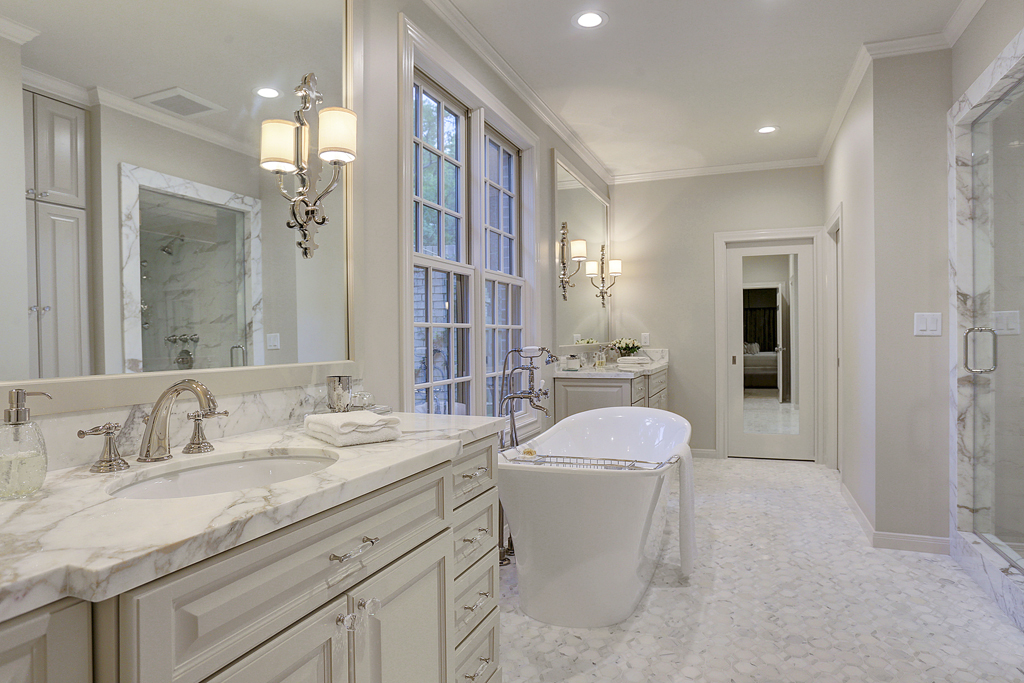
- Website: www.twosistersdesigns.com
- Email: carol@twosisdesigns.com
Here’s the truth about creating beautiful transitional spaces. The ideas are everywhere online. Pinterest is full of inspiration. But pulling it all together? That’s where most people struggle.
You can spend months shopping. You might order furniture that doesn’t fit. Colors that looked perfect online arrive wrong. Rooms almost work but something feels off. And suddenly you’ve spent more than planned.
This is why full service interior design exists. Not because you lack taste. Not because you lack vision. But because creating cohesive spaces requires expertise. It needs trade access. And honestly, it takes time.
Two Sisters Designs specializes in full service interior design for Houston homeowners. We create timeless transitional spaces. We handle everything from initial consultation through final installation. You get professionally designed rooms. Without the stress of doing it yourself.
Our Full Service Interior Design Includes:
Complete Space Planning: We measure your rooms carefully. We create layouts that function beautifully. Traffic flow gets considered. Furniture placement is optimized. Proportions are perfect. You get spaces that actually work.
Curated Furniture Selection: We source pieces fitting your style and budget. Our trade access means better quality. We get competitive prices. We find furniture you can’t locate alone. Everything gets scaled perfectly.
Custom Color Palettes: We design color schemes for Houston homes specifically. Your palette coordinates throughout your space. It complements existing pieces. And it creates the exact mood you want.
Texture and Material Coordination: We layer textures that add depth. We select fabrics matching your lifestyle. Materials get chosen for durability and beauty. Everything feels cohesive and intentional.
Complete Styling Services: We handle every single detail. Artwork placement. Accessory selection. Finishing touches. You walk into rooms that feel complete. They look magazine worthy immediately.
Why Houston Homeowners Choose Us:
We understand Texas homes and architecture and how climate affects material choices. We source locally when possible. And we design spaces reflecting Houston’s sophisticated lifestyle.
Our approach balances beauty with practicality. You get stunning spaces that actually function. Fabrics that handle real life. Furniture that lasts for years. Design that works for your family.
We respect your budget and timeline. No surprise costs ever. No endless delays. Just transparent communication. And professional service. You know what to expect always.
Ready to Transform Your Space?
Most clients come to us feeling overwhelmed. They have Pinterest boards full of ideas. They’ve shopped unsuccessfully for months. They know what they want. But they can’t pull it together.
We take that stress away completely. You share your vision. We make it reality. The process is actually enjoyable. Someone else handles the details.
Full service design typically takes three to six months. For whole home projects. Single rooms complete in six to eight weeks. We work within your timeline. And your budget. To create spaces you’ll love.
For inspiration beyond décor, explore my tips for kitchen renovation houston.
Final Thoughts
Home decor transitional style offers the best of both worlds. You get traditional comfort. You gain modern simplicity. The result feels timeless and elegant. And genuinely livable every day.
This approach works for any home size. It adapts to most budgets. And it creates spaces that function beautifully. While looking sophisticated and polished. Whether you’re refreshing one room or redesigning everything, transitional style delivers lasting value.
But creating truly cohesive transitional spaces? That takes more than inspiration alone. It requires design expertise. Access to quality resources. And an eye for what works together. This is where professional full service interior design makes all the difference.
Ready to create a home that feels timeless and authentically you? Two Sisters Designs brings transitional style to life in Houston homes. Contact us today to schedule your consultation. Let’s design spaces you’ll love coming home to every single day.
Your home should feel like you, calm, beautiful, and thoughtfully designed. At Two Sisters Designs, we take the stress out of decorating and remodeling so you can enjoy the process and love the result.